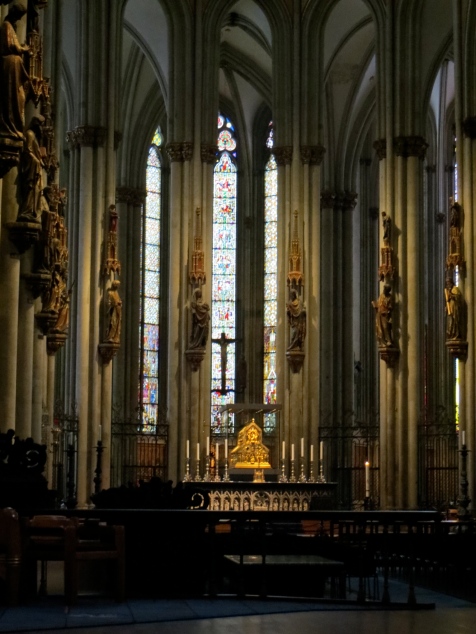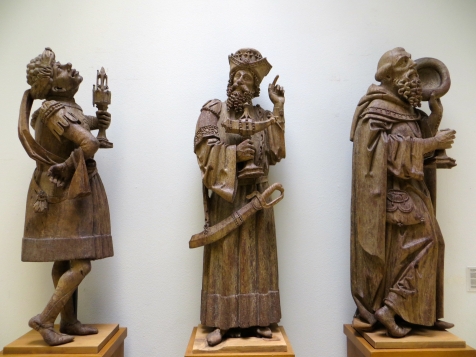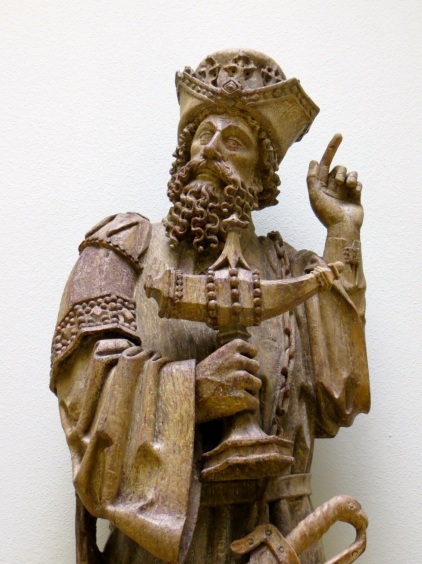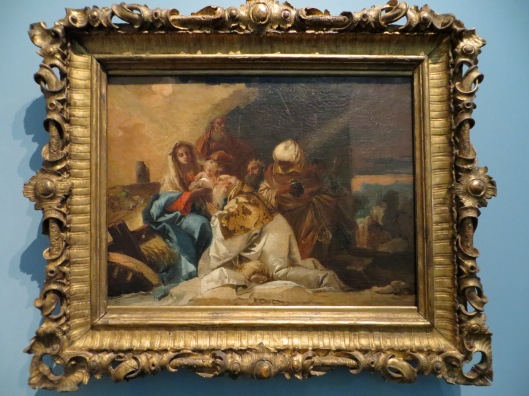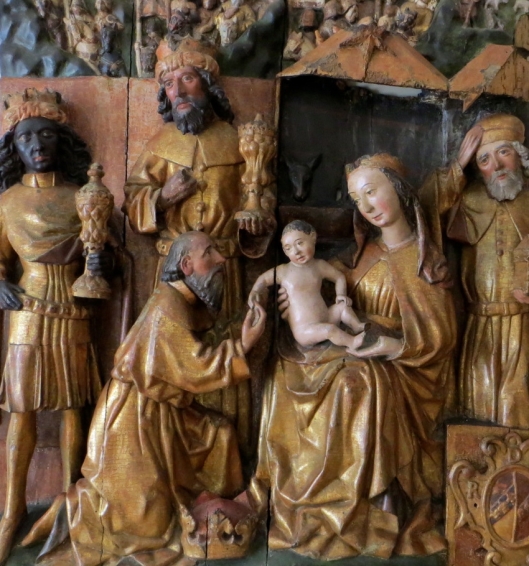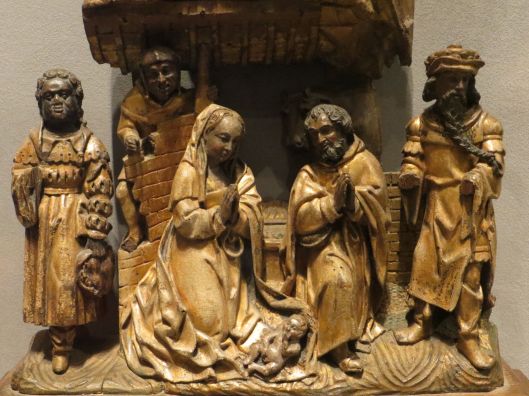Tags
catacombs, Magi, martyr, relic, reliquary, Saint Innocent, Saint Matthew, United States, Washington

Peter Paul Rubens, Massacre of the Innocents (detail), oil on panel (c. 1638), Alte Pinakothek, Munich, Germany
The Holy Innocents
The Massacre of the Innocents is sometimes invoked as an example of man’s potential for savagery and brutality in war. In Henry V, for example, King Henry conjures the specter of Herod while addressing the governor and citizens of Harfleur, warning:
Take pity of your town and of your people,
Whiles yet my soldiers are in my command; . . .
If not, why, in a moment look to see . . .
Your naked infants spitted upon pikes,
Whiles the mad mothers with their howls confused
Do break the clouds, as did the wives of Jewry
At Herod’s bloody-hunting slaughtermen.[1]
It should be remembered, however, that the Massacre of the Innocents was a calculated act, a politically motivated event, rather than a mere accident of war. Its victims were helpless children, all under the age of two years. According to the Golden Legend, the Holy Innocents, as they came to be called, were considered holy and innocent “by reason of their life, of the death they suffered, and of the innocence they attained.”[2]
Though mentioned only briefly in the Bible, the Holy Innocents were eventually bestowed their own feast day sometime during the late 4th to late 5th centuries.[3] Also known as Innocents’ Day or Childermas, the Feast of the Holy Innocents was once a day of role reversals, akin to the ancient Roman festival of Saturnalia, which placed children in authority over adults. Today, the Feast of the Holy Innocents, celebrated on 28 December, is a day of pranking and general tomfoolery similar to April Fools’ Day in some parts of the world. In the town of Ibi, Spain, for example, the festival of Els Enfarinats famously features a coup d’etat and a fierce battle of eggs and flour bombs that is waged throughout the town.
Who were the Holy Innocents, though, and why were they massacred in the first place?

Killing of the Innocents, stained glass, Strasbourg Cathedral, Strasbourg, France
The Slaughter of the Innocents
The only Gospel writer who mentions the Massacre of the Innocents is Saint Matthew, who explains that Herod ordered the massacre after mysterious Magi from the east arrived in Jerusalem inquiring about a newborn king. “Where is the one who has been born king of the Jews?” the Magi asked, somewhat indiscreetly. “We saw his star when it rose and have come to worship him.”[4]
According to the Golden Legend, “Herod was troubled when he heard of this, fearing that someone might have been born of the true royal line and might expel him as a usurper of the throne.”[5] Nevertheless, perceiving an opportunity to discover the whereabouts of his potential challenger, Herod feigned interest in worshipping the new king and slyly asked the Magi to bring him news once they had found him. “Go and search carefully for the child,” he told them. “As soon as you find him, report to me, so that I too may go and worship him.”[6] Herod had no intention of worshipping the child, however. Rather, he intended to kill the newborn king, quite literally in his infancy.

Sandro Botticelli, Adoration of the Magi (detail), tempera and oil on panel (c. 1478-1482), National Gallery of Art, Washington, DC
Warned in a dream not to return to Herod, the Magi returned home by another route. According to the Golden Legend, when the Magi did not report back to him, Herod initially thought they had been deceived by the star and were too ashamed to face him with the news. Herod subsequently gave up the search for the child. Eventually, however, “when he heard what the shepherds had reported and what Simeon and Anna had prophesied, all his fears returned.”[7]
According to Saint Matthew, “When Herod realized that he had been outwitted by the Magi, he was furious, and he gave orders to kill all the boys in Bethlehem and its vicinity who were two years old and under, in accordance with the time he had learned from the Magi. Then what was said through the prophet Jeremiah was fulfilled: ‘A voice is heard in Ramah, weeping and great mourning, Rachel weeping for her children and refusing to be comforted, because they are no more.’”[8]
Courage and Callousness
In his study From Criminal to Courtier: The Soldier in Netherlandish Art, 1550-1672, David Kunzle explains that the Massacre of the Innocents became an increasingly popular subject in art in the 13th and 14th centuries.[9] Over time, two “non-biblical, legendary embellishments” crept into depictions of the event, altering the way the massacre was perceived. The first, which lent “both realism and political edge” to such scenes, was the portrayal of mothers fiercely resisting the slaughter of their children.[10] The second was the inclusion of Herod himself, callous and dispassionate amidst the carnage.
Works by artists such as Cornelius van Haarlem and Peter Paul Rubens attempt to portray some of the confusion, anguish, and brutality that surrounded the massacre. In these depictions, the mothers of the Holy Innocents desperately interpose themselves between Herod’s soldiers and the helpless children of Bethlehem. They claw at the soldiers, tearing their faces and gouging their eyes. They frantically shield their children, but to no avail. Pale, lifeless corpses already litter the landscape.

Peter Paul Rubens, Massacre of the Innocents (detail), oil on panel (c. 1638), Alte Pinakothek, Munich, Germany
Kunzle notes that though not mentioned in the Bible, the resistance of the mothers “is surely as natural as the grief.”[11] He further comments that their resistance may have been an “indictment of those unnatural mothers who instead of trying to protect their children like the mothers of Bethlehem . . . abandoned, killed or aborted them, crimes increasingly common and increasingly severely punished in the 16th century, after being more or less winked at in earlier centuries.”[12]
In contrast, Herod is commonly portrayed as a cold, detached observer of the events. Often, he is shown seated on a high throne,“ordaining the massacre.”[13] The position, Kunzle argues, emphasizes Herod’s pride and arrogance.[14] In Matteo di Giovanni di Bartolo’s The Massacre of the Innocents, for example, Herod is portrayed as a large figure with a crown, peering down from a throne from which he calmly directs the violence below.[15] Sometimes, Herod is also depicted with counsellors, whose presence, Kunzle suggests, “gives the order to massacre the colour of a deliberate act of state rather than a furious personal impulse.”[16] Herod has also been known to be accompanied by a pig.

Reliquary Shrine with Scenes from the Life of Christ (detail), champlevé enamel on copper (c. 13th century), Walters Art Museum, Baltimore, Maryland. At right, Herod sits enthroned, his arm raised, while the devil whispers in his ear.
Herod’s Pig
“Those who kill, get killed,” Kunzle tells us.[17] “Killers of sons get killed by sons.”[18] Unsurprisingly, then, Herod’s barbarous order did not go unpunished. We learn from the Golden Legend that one of Herod’s infant sons had been “given to a woman in Bethlehem for nursing” and consequently was slain with the Holy Innocents during the massacre.[19] On hearing this, the emperor August allegedly remarked, “I had rather be one of Herod’s pigs than sons.”[20] Apparently, this comment inspired one 15th-century artist to insert a pig into a version of the Massacre of the Innocents.[21] I am not aware of other such pigs loitering about similar depictions of the event, however.
The First Christian Martyrs
The Holy Innocents are considered the first Christian martyrs, and as martyrs, they are sometimes shown holding palm branches, a common symbol of martyrdom.[22] It is unclear, though, how many children may actually have been killed in the massacre. According to the Catholic Encyclopedia, “The Greek Liturgy asserts that Herod killed 14,000, the Syrians speak of 64,000, [and] many medieval authors of 144,000,” a number apparently derived from the Book of Revelation.[23] However, considering the parameters of Herod’s order—to kill “all the boys in Bethlehem and its vicinity who were two years old and under”—the number of dead would likely have been far more modest than any of these estimates. In her book Saints in Art, Rosa Giorgi suggests the number killed may have been around twenty.[24]. Giorgi notes that “images of this episode have traditionally been more focused on the atrocious violence and mothers’ anguish than the number of casualties.”[25]

Mount Saint Sepulchre Franciscan Monastery (Franciscan Monastery of the Holy Land in America), Washington, DC, USA
The Relics of Saint Innocent
The Catholic Encyclopedia identifies a number of churches that purportedly possess relics of Holy Innocents. These churches include the Abbey of Saint Justina (Abbazia di Santa Giustina) in Padua, Italy; Saint Mary Major (Santa Maria Maggiore) in Rome, Italy; Lisbon Cathedral (Sé de Lisboa) in Lisbon, Portugal; and Milan Cathedral (Duomo di Milano) in Milan, Italy. The Basilica of Saint Paul Outside the Walls (Basilica Papale San Paolo fuori le Mura) in Rome also claims to possess relics of the Holy Innocents, and an apsidal mosaic in the church depicts five of the Holy Innocents as young boys, dressed in white, bearing palm branches. A curious monastery in Washington, DC, also lays claim to a link to the Holy Innocents, though not through relics like those of the churches described above.
Descending into the fake catacombs of the Franciscan Monastery of the Holy Land in America, in the Brooklands neighborhood of Washington, DC, is slightly unsettling. After shuffling down a set of stairs and under an arch labeled “Nazareth,” one first encounters a gleaming, marble replica of the shrine of the Annunciation in Nazareth before continuing into the “catacombs.” The experience is perplexing, like drinking a German beer in the Germany Pavilion at Disney’s Epcot Center. Still, there is a certain allure to place. It is air-conditioned and dust-free, and not particular creepy—until one happens on the body of a small boy, encased in glass, resting serenely on red silk cushions.
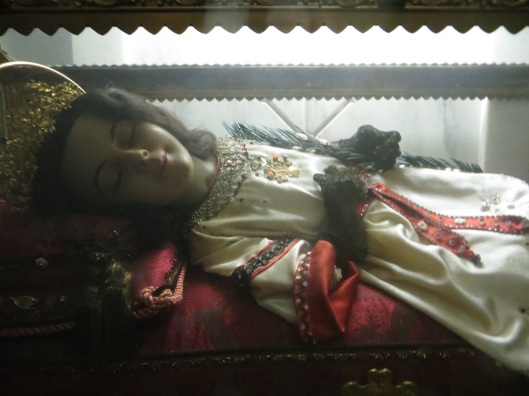
Relics of Saint Innocent, Franciscan Monastery of the Holy Land in America, Washington, DC
The boy is crowned with a golden wreath, above which hovers a golden halo. His head is tilted slightly to the right and a gentle smile plays across his pale, waxen face. He wears a white silken tunic, which is bejeweled around the neck, and a red ribbon hangs loosely about his waist. His hands and feet are covered in golden gauze, and his left hand, crumpled loosely into a fist, rests atop his body cradling a palm branch.

Saint Innocent’s hands are visible through the gauze covering his hands. The palm frond tucked beneath his left hand is a symbol of martyrdom.
The boy is Saint Innocent (Saint Innocentius), a boy no older than eight years, who was apparently killed during the Roman persecutions of the 2nd century. Near his body, a sign explains that he was “buried in the Catacombs of St. Callistus for several centuries” before his relics were removed to a chapel in Hinsdale, Illinois, and then subsequently transferred to Washington, DC. The sign further states that a phial of the boy’s blood, an indicator of martyrdom, was also found with the body along with an inscription that read “Innocentius in pace,” or “Innocent resting in peace.” The phial found in the catacombs is now stored in the glass reliquary case with the saint’s body. Lastly, the informational sign explains that “[w]hile the skull [of Saint Innocent] has been covered with a beautiful wig, the hands and feet are covered only with gold gauze, thus permitting the bones to be seen easily.”
Saint Innocent is not a Holy Innocent, but he serves as a representative of all those who, as the Golden Legend states, were “innocent in their lives and upright in faith.”[26] Recognizing this symbolic connection, another sign above Saint Innocent’s reliquary reminds visitors that December 28th is the Feast of the Holy Innocents, a day of remembrance of Christianity’s young, first martyrs.

Interior of the Mount Saint Sepulchre Franciscan Monastery (Franciscan Monastery of the Holy Land in America), Washington, DC, USA
[1] William Shakespeare, Henry V, III, iii, 27-41.
[2] Jacobus de Voragine, 1 The Golden Legend: Readings on the Saints 56 (William Granger Ryan trans., 1993).
[3] The feast is first mentioned in the Leonine Sacramentary of about 485.
[4] Matthew 2:2.
[5] Golden Legend, supra note 2, at 57.
[6] Matthew 2:8.
[7] Golden Legend, supra note 2, at 57.
[8] Matthew 2:16-18.
[9] David Kunzle, From Criminal to Courier: The Soldier in Netherlandish Art 1550-1672 (2002), at 35.
[10] Id.
[11] Kunzle, supra note 9, at 46.
[12] Id.
[13] Id. at 38.
[14] Id. at 42.
[15] Painted circa 1480-1490, the work is located at the Museo di Capodimonte, Naples, Italy.
[16] Kunzle, supra note 9, at 42.
[17] Id. at 39.
[18] Id.
[19] Golden Legend, supra note 2, at 58.
[20] Kunzle, supra note 9, at 40 (quoting Macrobius). However, this quip may relate to a different event altogether. The Golden Legend states Augustus made these remarks after learning that Herod had deliberately ordered the death of two of his sons. In response, the Golden Legend quotes Augustus as saying, “I would rather be Herod’s swine than his son, because he spares his swine but kills his sons.” Golden Legend, supra note 2, at 58.
[21] Kunzle, supra note 9, at 40-41.
[22] See, e.g., Albrecht Classen, Childhood in the Middle Ages and the Renaissance: The Results of a Paradigm Shift in the History of Mentality 123 (2005) (“The Holy Innocents became the first Christian martyrs because of their chronological and geographical proximity to Christ and because they died in his stead.”); Rosa Giorgi, Saints in Art 167 (Stefano Zuffi ed. & Thomas Michael Hartmann trans., 2002). In Ruben’s Massacre of the Innocents at the Alte Pinakothek in Munich, Germany, angels from heaven tumble to earth bearings crowns of martyrdom instead.
[23] 7 Catholic Encyclopedia 420 (Charles G. Herbermann et al., eds 1910). The verse from Revelation cited in the text above reads, “And they sung as it were a new song before the throne, and before the four beasts, and the elders: and no man could learn that song but the hundred and forty and four thousand, which were redeemed from the earth.” Revelation 14:3.
[24] Giorgi, supra note 23, at 167.
[25] Id.
[26] Golden Legend, supra note 2, at 56.

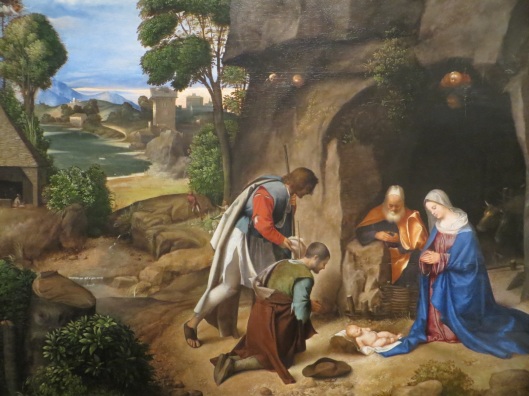






 Eventually, the star appeared. “When Christ was born in Bethlehem, His Star began to rise in the manner of the sun, bright shining. It ascended above the Hill of Vaws, and all that day in the highest air it abode without moving, insomuch that when the sun was hot and most high there was no difference in shining betwixt them.” Following the day of the nativity, “the Star ascended up into the firmament, and it had right many long streaks and beams, more burning and brighter than a brand of fire; and, as an eagle flying and beating the air with his wings, right so the streaks and beams of the Star stirred about.”
Eventually, the star appeared. “When Christ was born in Bethlehem, His Star began to rise in the manner of the sun, bright shining. It ascended above the Hill of Vaws, and all that day in the highest air it abode without moving, insomuch that when the sun was hot and most high there was no difference in shining betwixt them.” Following the day of the nativity, “the Star ascended up into the firmament, and it had right many long streaks and beams, more burning and brighter than a brand of fire; and, as an eagle flying and beating the air with his wings, right so the streaks and beams of the Star stirred about.”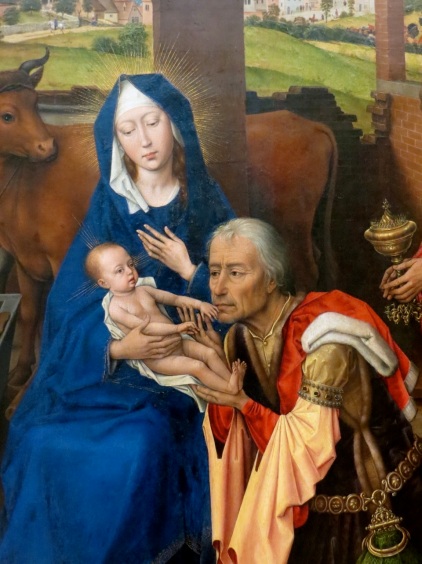


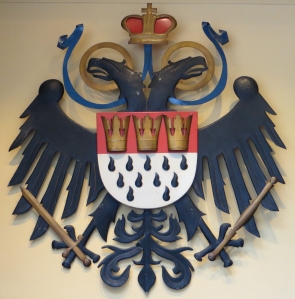 The three skulls in the shrine were also graced with golden crowns, apparently given to the church by King Otto IV of Brunswick in 1199. Incidentally, in recognition of the importance of the kings’ relics, three golden crowns appear on the coat of arms of the city of Cologne. As Gerald J. Brault explains in Early Blazon: Heraldic Terminology in the Twelfth and Thirteenth Centuries with Special Reference to Arthurian Heraldry, “Three crowns were frequently an allusion to the Three Wise Men whose relics were brought by Frederick I Barbarossa from Milan to Cologne in 1164. Commemorating this event, three crowns are featured in the arms of the City of Cologne dating from the end of the thirteenth century as well as on the seal of the University of Cologne from 1392 onwards.”
The three skulls in the shrine were also graced with golden crowns, apparently given to the church by King Otto IV of Brunswick in 1199. Incidentally, in recognition of the importance of the kings’ relics, three golden crowns appear on the coat of arms of the city of Cologne. As Gerald J. Brault explains in Early Blazon: Heraldic Terminology in the Twelfth and Thirteenth Centuries with Special Reference to Arthurian Heraldry, “Three crowns were frequently an allusion to the Three Wise Men whose relics were brought by Frederick I Barbarossa from Milan to Cologne in 1164. Commemorating this event, three crowns are featured in the arms of the City of Cologne dating from the end of the thirteenth century as well as on the seal of the University of Cologne from 1392 onwards.”